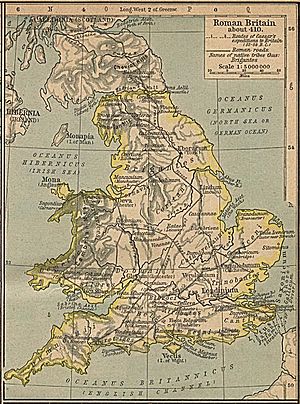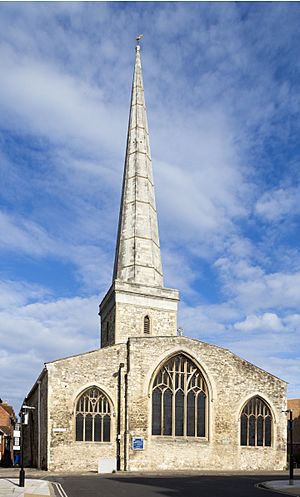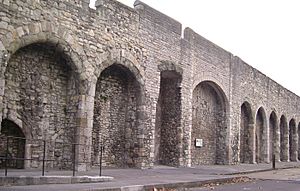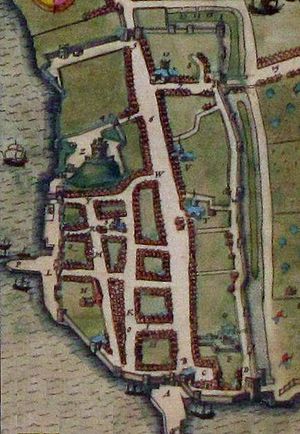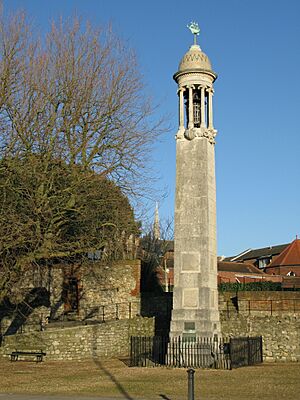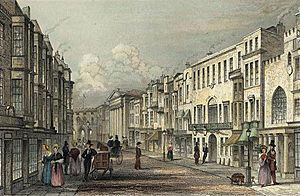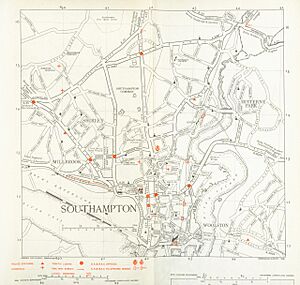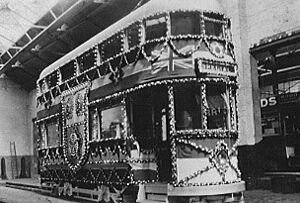History of Southampton facts for kids
Southampton is a city located in Hampshire, England. People have lived in this area since the Stone Age. Its history has been shaped by its special location on a large river mouth (estuary) near the English Channel. It also has an unusual double high-tide, which was great for ships. Being close to Winchester and London, which were important capitals, also played a big part in its story. Southampton was a key regional center for many centuries and became an official city in 1964, thanks to Queen Elizabeth II.
Southampton grew into an important port during the Middle Ages. Its fortunes went up and down for hundreds of years until the Victorians expanded it greatly. As a busy trading hub, an industrial town, and a vital military departure point, Southampton was a major target during World War II. It was badly damaged by bombs. After the war, the city was rebuilt. New developments, like those needed for cars, changed Southampton's look and feel a lot.
Contents
- Ancient Times: Early Settlements
- Roman Era: Clausentum (43–410 AD)
- Anglo-Saxon Period: Hamwic (400–1066)
- Vikings: Raids and Changes (700–1066)
- Normans: A New Era (1066–1154)
- Medieval Period: Growth and Challenges (1154–1485)
- Tudor Period: Changing Fortunes (1485–1603)
- Stuart Period: Pilgrims and Plague (1603–1714)
- Georgian Era: Spa Town and Canals (1714–1795)
- Regency Period: Bridges and Boundaries (1795–1837)
- Victorian Era: Major Expansion (1837–1901)
- Edwardian Period: The Titanic (1901–1914)
- World War I: Military Port (1914–1918)
- Interwar Period: Modernizing the City (1918–1939)
- World War II: The Blitz and D-Day (1939–1945)
- Post War: City Status and Changes (1945–2000)
- 21st Century: A Modern Port (2001 on)
- Memorials: Remembering History
- Places of Worship: Past and Present
- Aviation History: From Spitfires to Flying Boats
- Shipbuilding History: A Major Industry
- Transport History: Moving People and Goods
- Images for kids
Ancient Times: Early Settlements
Stone Age Discoveries
Many gravel pits have been dug in the Southampton area. These digs have often uncovered tools from the Stone Age. Evidence of a Stone Age settlement was even found at Priory Avenue in St Denys.
Bronze Age Finds
Objects from the Bronze Age have been found on Southampton Common. Grave-diggers in the cemetery and workers building a reservoir found these items. More Bronze Age discoveries were made near Cobden Bridge.
Iron Age Earthworks
Signs of Iron Age earthworks have been discovered at Lordswood and Aldermoor. In the city center, archaeologists have found evidence of Iron Age buildings.
Roman Era: Clausentum (43–410 AD)
The Roman Settlement of Clausentum
Ancient Roman records mention a settlement called Clausentum in Roman Britain. These records say it was about 20 miles (32 km) west of Chichester and 10 miles (16 km) from Winchester. Around 1770, a historian named John Speed suggested that Clausentum was located where Bitterne Manor is today.
Uncovering Roman History
In 1792, Reverend Richard Warner explored these claims. He found a ditch, a bank, and some Roman coins. Since then, more investigations have taken place. Most experts now agree that Bitterne Manor was the site of Clausentum. This location, tucked inside a sharp bend in the River Itchen, made it a good defensive spot.
A Busy Roman Port
Even though its exact location was debated, it's clear there was a Roman settlement at what is now Bitterne Manor. Archaeological finds show that this site was an important trading port with impressive buildings. Traces of a Roman Road running from Bitterne Manor to Wickham have also been found. The Romans left the settlement around 410 AD, when their rule in Britain ended.
Anglo-Saxon Period: Hamwic (400–1066)
Moving Across the River
The Anglo-Saxons moved the town's center across the River Itchen. This new settlement was in what is now the St Mary's area. It was known as Hamwic or Hamtun. Both names were used for the same place. By the mid-11th century, it was called South Hamtun.
A Thriving Saxon Town
Archaeological digs have revealed parts of Hamwic's street plan. They've also uncovered one of Europe's best collections of Saxon artifacts. These discoveries show that Hamwic was a planned town. It became an important port, trading with other parts of Europe. It was also a center for royal administration. Hamwic even had a Royal Mint, making coins for several Anglo-Saxon Kings from 786 to 858 AD.
A Hub for Travelers
Hamwic was also a departure point for pilgrims, like St. Willibald, who traveled to important European cities like Rome.
Vikings: Raids and Changes (700–1066)
Viking Attacks
Vikings launched raids on Southampton, which disrupted trade with other countries. These attacks led to changes in how Wessex (an Anglo-Saxon kingdom) was organized. Important industries that were strong in Hamwic moved further inland to new forts in Winchester. This contributed to Hamwic's decline.
King Canute's Connection
Archaeological evidence shows settlements from the 10th century. There was also a defended area that later became the medieval walled town. The Viking King Canute the Great defeated the Anglo-Saxon King Ethelred the Unready in 1014. Canute was crowned in Southampton. The famous story of him trying to "command" the tide to stop might have happened here.
Normans: A New Era (1066–1154)
Prosperity After the Conquest
Southampton's success was secured after the Norman Conquest in 1066. It became the main port for travel between Winchester (England's capital until the early 12th century) and Normandy.
French and English Quarters
The Domesday Book shows that Southampton already had separate French and English areas when the Normans arrived. The King owned several properties there, for which rent was paid.
St. Michael's Church
Archaeological evidence dates the start of St. Michael's Church to 1070. The church was dedicated to St. Michael, who is the patron saint of Normandy. An Augustinian priory was also founded at St. Denys in 1127.
Medieval Period: Growth and Challenges (1154–1485)
Royal Visits and Trade
Henry II, the first King from the Plantagenet family, often visited Southampton. He established Southampton Castle, mainly used to store the King's wine. Surviving 12th-century merchant houses, like King Johns House, show how wealthy the town was.
By the 13th century, Southampton was a leading port. It was especially involved in trading French wine and English wool. The Wool House was built in 1417 as a warehouse for the wool trade with Flanders and Italy.
Hospitals and Recreation
The St Mary Magdalen leper Hospital was set up north of the town by 1173. St Julians Hospital, also known as God's House Hospital, was founded around 1196. The Franciscan friary was later built next to God's House hospital. The game of Bowls was first played regularly on the green next to God's House Hospital in 1299. This green still exists and is the world's oldest surviving bowling green.
French Attack and City Walls
The town was attacked and sacked by the French in 1338. After this attack, the city's walls, some parts dating from 1175, were greatly improved. Since there wasn't enough money for a full new wall, existing outer walls of merchant houses were connected to form part of the defenses. The city walls include God's House Tower, built in 1417. This was England's first building specifically designed for artillery. The walls were finally finished in the 15th century, and much of them remain today.
The Black Death and a Famous Plot
The Black Death plague reached England in 1348 through merchant ships visiting Southampton. In 1415, just before King Henry V of England left Southampton for the Battle of Agincourt, the leaders of the 'Southampton Plot' were tried and found guilty of treason at the Red Lion pub. They were then executed outside the Bargate. During the Middle Ages, shipbuilding became a very important industry, and it stayed that way for centuries. The city became a self-governing county in 1447.
Tudor Period: Changing Fortunes (1485–1603)
Tudor House and Trade
Southampton's Tudor House was built in 1495. It has been a family home, an artist's studio, and even housed businesses. Today, it's a museum.
Southampton's economy changed a lot during the Tudor period. For a time, all exports of tin and lead had to go through Southampton. Trade with the Channel Islands also increased. In 1554, Southampton was given special rights to export wool to the Mediterranean and import sweet wine. However, at other times, the port declined as trade shifted towards London. Southampton was also a convenient port for pirates who raided Spanish ships.
New Fortifications and Education
Around 1540, Henry VIII built Hurst, Calshot, Cowes, and Netley castles along Southampton Water. This meant Southampton didn't rely as much on its own city walls for defense. In 1553, King Edward VI established the Free Grammar School of the Mayor Baliffs and Burgesses of the Towne and County of Southampton. This school, now called King Edward VI School, Southampton, was founded with money left by William Capon.
Stuart Period: Pilgrims and Plague (1603–1714)
Departure Point for Pilgrims
The port was the original departure point for the Pilgrim Fathers aboard the Mayflower in 1620. A memorial to them can be found on Town Quay. Since then, millions of emigrants have left the Old World from Southampton to start new lives in places like the USA, Australia, and Canada.
English Civil War and Plague
In 1642, during the English Civil War, a Parliamentarian army moved into Southampton to defend it. A Royalist army tried to take the town in March 1644 but was stopped. The Battle of Cheriton later removed the threat to Southampton.
In June 1664, the Black Death returned to Southampton. This new outbreak caused serious problems, and by November 1666, 1700 people had died.
Isaac Watts
Isaac Watts, born in Southampton in 1674, wrote the words to the famous hymn O God Our Help in Ages Past. He attended the Free Grammar School. His father, also named Isaac, was imprisoned in the Bargate because of his non-conformist religious beliefs.
Georgian Era: Spa Town and Canals (1714–1795)
A Fashionable Spa Town
Southampton became a Spa Town in 1740 after a spring of Chalybeate water was discovered. This area was turned into spa gardens and even received royal visitors. This encouraged fashionable society to come to Southampton, helping the town grow.
By the 1760s, Southampton was also popular for sea bathing, even though it didn't have the best beach. Special buildings were constructed at West Quay for this purpose. These baths were filled and emptied by the tide. One even had an adjustable floor! The building, called the Long Rooms, had a long walkway with views of the water for both bathers and onlookers.
The Polygon Development
The Polygon was a housing and business project designed in 1768. It was meant for Southampton's fashionable visitors. The plan was to build 12 houses, a hotel, shops, a meeting room, and a decorative lake. Only three houses and the hotel were finished by 1773, as the project ran into money problems and was never completed. These buildings have since been taken down.
Coaching and Canals
The town's popularity led to more coaching traffic. Several coaching inns, like the Dolphin Hotel, were set up. This trade continued until railways made coaches less important.
There was also a lot of interest in building canals. The Redbridge to Andover canal was finished in 1796. Plans to link Southampton and Salisbury by canal also gained momentum. A tunnel was started under the Marlands to extend the canal into Southampton's center, but it was never completed.
Industrial Revolution Steps
Walter Taylor in Southampton mechanized the process of making wooden blocks in the 18th century. This was a big step in the Industrial Revolution. He gained a monopoly on supplying wooden rigging blocks to the Royal Navy from 1759 to 1803.
Regency Period: Bridges and Boundaries (1795–1837)
Crossing the Itchen River
For centuries, the only ways to cross the River Itchen in this area were at Mansbridge, far upstream, and by Itchen Ferry village. The Northam Bridge Company was formed in 1796. They built a toll bridge at Northam, which opened in 1799. New roads connected this bridge to Southampton and Botley, Hampshire. Southampton was further connected to Portsmouth by another toll bridge at Bursledon.
The Floating Bridge also connected Southampton to Woolston and Portsmouth on the east bank of the River Itchen in 1836.
City Changes
Southampton was one of the areas reformed by the Municipal Corporations Act 1835. This act changed how local governments worked. The painter John Everett Millais was born in the city in 1829. Southampton Solent University's art gallery is named the Millais Gallery in his honor.
Victorian Era: Major Expansion (1837–1901)
Docks and Railways
The town grew significantly during the Victorian era. The Southampton Docks company was formed in 1835. The first dock opened on August 29, 1842. The Royal Mail Steam Packet Company began operating its services from Southampton in May 1843, making it an official packet station. The docks continued to develop for decades.
The railway line from Southampton to London fully opened in May 1840. By 1847, Southampton was connected to Dorchester by rail. In 1866, a branch line extended the railway over the River Itchen to Netley.
Gateway to the Empire
With good transport links, Southampton became the main departure point for emigrants to North America and Canada in January 1844. The Southampton Emigration and Shipping Company was formed in 1846. Southampton became known as The Gateway to the Empire, as many emigrants passed through to start new lives in the United States, Canada, South Africa, and Australia.
Public Health and Slum Clearance
Cholera epidemics in 1848–49 and 1865 caused great concern. These outbreaks were centered in the poor areas of the old medieval town. Sewers were built in the 1840s and 1870s. In 1894, a report on poverty in the town showed very high population density in the slums. The Simnel Street and West Quay Improvement plan then cleared these slum areas, created new streets, and built a lodging house called St Michaels House, which opened in 1899.
Edwardian Period: The Titanic (1901–1914)
The Titanic Disaster
Like most luxury liners of its time, RMS Titanic sailed from Southampton. Most of the crew came from Southampton; 549 people from the city died when the ship sank. The Maritime museum in the old Wool House used to have an exhibition about the vessel, but it has now moved to the SeaCity Museum.
World War I: Military Port (1914–1918)
Southampton was named the No. 1 Military Embarkation Port in August 1914. Much of Southampton Common was taken over by the military. A total of 8,149,685 troops and their equipment left for mainland Europe through the port. A steady flow of refugees, prisoners of war, and 1,177,125 wounded soldiers returned to England through Southampton.
Interwar Period: Modernizing the City (1918–1939)
City Expansion and Road Changes
In 1920, several surrounding districts like Bitterne, Woolston, and Sholing became part of Southampton. The period between the two World Wars saw a big increase in traffic, with cars and trams becoming more common. It became essential to create new routes around the Bargate because its central arch was a major blockage. By 1931, a tram passed through the Bargate every 30 seconds. To solve this, several old buildings and parts of the medieval walls were demolished. In 1932, the Bargate was bypassed on its eastern side, and in 1938, it became an island when bypassed on its western side.
Removing Tolls
On March 25, 1929, Southampton Corporation bought Northam Bridge. On May 16, 1929, the tolls on that bridge were removed. Tolls at Lances Hill, Hedge End, and the bridge at Bursledon were also abolished. The only remaining toll in Southampton was at the Floating Bridge. This was eventually taken over by Southampton Corporation in 1934 and remained a toll-crossing until it closed in 1977.
World War II: The Blitz and D-Day (1939–1945)
Air Raids on Southampton
Southampton was hit very hard during the Second World War. Much of the city was destroyed during the Blitz in November 1940. The Luftwaffe dropped 476 tons of bombs on the city. Southampton was a prime target because it was a major port and industrial area. Also, the Supermarine Spitfire airplane was designed and built here.
On September 15, 1940, the Supermarine factory in Woolston was bombed, killing many people. Two days later, the factory was destroyed. The main blitz, a series of continuous nighttime raids, began on November 23, 1940. A total of 137 people died during this period.
One building that survived the bombing was Southampton's oldest, St. Michael's Church. Its spire was an important landmark for German pilots, so they were ordered not to hit it. The last air raid on Southampton happened on November 5, 1944.
D-Day Preparations
In July 1943, a military exercise showed that Southampton's port could handle 44,000 troops per high tide. By D-Day, this number had increased to 53,750 troops and 7,070 vehicles, thanks to new facilities.
Besides embarking troops, Southampton was used for other preparations for the Invasion of Europe. US servicemen and Lend-Lease imports arrived at the docks. Sections of Mulberry Harbour (temporary harbors used on D-Day) were built in Southampton's harbor.
Southampton was at the center of 'Area C', a huge gathering area in southern Hampshire for troops and equipment. After D-Day, Southampton continued to work at full capacity to resupply the Allied Forces in Europe.
Post War: City Status and Changes (1945–2000)
Southampton was officially granted city status in 1964. In 1967, Southampton took in parts of the Nursling and Rownhams parishes, and its boundaries have mostly stayed the same since.
Southampton lost its County Borough status in 1972. However, it became a Unitary Authority in 1997, meaning it became administratively independent of Hampshire County Council.
On April 29, 1952, Hartley University College was granted a Royal Charter, giving the University of Southampton full university status. The university's medical school opened in 1971.
21st Century: A Modern Port (2001 on)
Southampton remains an important ocean liner port today. It is frequently visited by luxury ships like P&O's MV Oriana and Cunard's RMS Queen Mary 2, MS Queen Victoria, and MS Queen Elizabeth.
Memorials: Remembering History
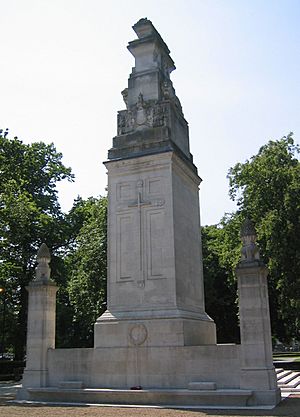
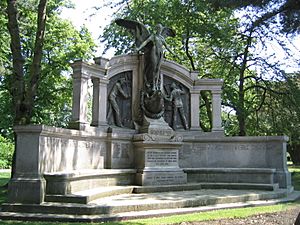
The Cenotaph
Southampton is home to Sir Edwin Lutyens' first permanent cenotaph, which was the model for the famous cenotaph in Whitehall, London. This memorial honors the city's dead from World War I. When it was unveiled on November 6, 1920, it had 1,800 names, later increasing to 2,008. You can find it in Watts (West) Park, across from the Titanic memorial.
Titanic Memorials
A memorial to the engineers of the RMS Titanic is located in Andrews (East) Park, on Above Bar Street. There is also a memorial to the musicians who played on the Titanic just opposite the main memorial.
Isaac Watts Memorial
The Watts memorial in the city's West Park was unveiled in 1861. The tune of his famous hymn, "O God our help in Ages Past," can be heard when the Civic Centre clock chimes.
Places of Worship: Past and Present
Holyrood Church
Holyrood Church was one of the original five churches serving the walled town. Built in 1320, the church was destroyed by enemy bombing during the blitz in November 1940. In 1957, the church's remains were dedicated as a memorial to the sailors of the Merchant Navy.
St. Michael's Church
St. Michael's Church is believed to have started in 1070. The building has been added to many times, but its central tower dates from Norman times.
St. Mary's Church
St. Mary's Church is the largest church in the city. Its origins can be traced back to the first Saxon settlements in the 7th century.
Aviation History: From Spitfires to Flying Boats
Supermarine and the Spitfire
The famous Spitfire airplane was developed and first built in the suburb of Woolston. Its designer, Reginald Mitchell, lived in Highfield. The Spitfire was a direct descendant of experimental aircraft built by Supermarine that competed in the Schneider Trophy in the 1930s. Supermarine was taken over by Vickers in 1928.
Other Aviation Contributions
Many aircraft companies were based around Hamble-le-Rice from the 1930s to the 1950s, including Folland Aviation. The history of the area's contribution to aviation is celebrated at Solent Sky (formerly Southampton Hall of Aviation), near Itchen Bridge. BOAC had a flying boat base in the docks, serving British colonial possessions in Africa and Asia in the 1930s and 1940s.
Shipbuilding History: A Major Industry
Vosper Thornycroft
The John I. Thornycroft & Company shipyard was a major employer in Woolston from 1904 to 2004. The yard built and repaired many ships for the Royal Navy and was especially busy during both World Wars. John I. Thornycroft & Company merged with Vosper & Co. in 1966 to become Vosper Thornycroft. The yard closed in 2004 when the business moved to Portsmouth.
Day, Summers & Co.
The Day Summers & Co. shipyard at Northam launched its first iron steamship in October 1840. It went on to build mail ships for the growing services operating from Southampton's new docks. The firm also built specialized vessels, including a submarine and luxury steam yachts. During World War I, the yard built tugs, minesweepers, and refrigerated barges. The yard closed in January 1929.
Transport History: Moving People and Goods
The Floating Bridge
The Floating Bridge opened in 1836. It connected Southampton to Woolston, which was a separate village at the time. The Floating Bridge was bought by Southampton Corporation in 1934. This service continued until 1977, when the Itchen Bridge was opened.
Trams in Southampton
Horse-drawn trams first appeared in Southampton in 1879. Electric trams were introduced in 1900. From 1908, Southampton Corporation built most of its own trams. Some specially designed trams introduced in 1923 had unique rounded roofs, allowing them to pass through the central arch of the Bargate. During World War II, Southampton's trams were parked overnight in sidings on the Common for safety. They were painted battleship grey from 1942. Only one tram was lost to enemy bombing. Southampton's trams were gradually removed from service during 1948 and 1949, with the last tram running on December 31, 1949.
Buses Take Over
Southampton's trams were replaced by a fleet of diesel-engined buses. Buses had already been used in some parts of the city not served by trams. Some surviving buses from 1949 are now looked after by a heritage trust.
Railways and Stations
The railway arrived in Southampton in 1839. The first permanent station was Southampton Terminus, near Canute Road. In 1847, Southampton Terminus was linked to Dorchester by railway. In 1892, the London and South Western Railway Company bought Southampton Docks. This close relationship between the docks and railways allowed special 'Boat Train' services to connect with transatlantic liners. Trains also ran directly onto the Royal Pier to connect with ferry services.
The decline of transatlantic passenger liners and the development of the Southampton Container Terminals changed the economics of Southampton Terminus. Passenger services stopped on September 9, 1966. Southampton Central, originally Southampton West, is now the main railway station for Southampton.
Images for kids


